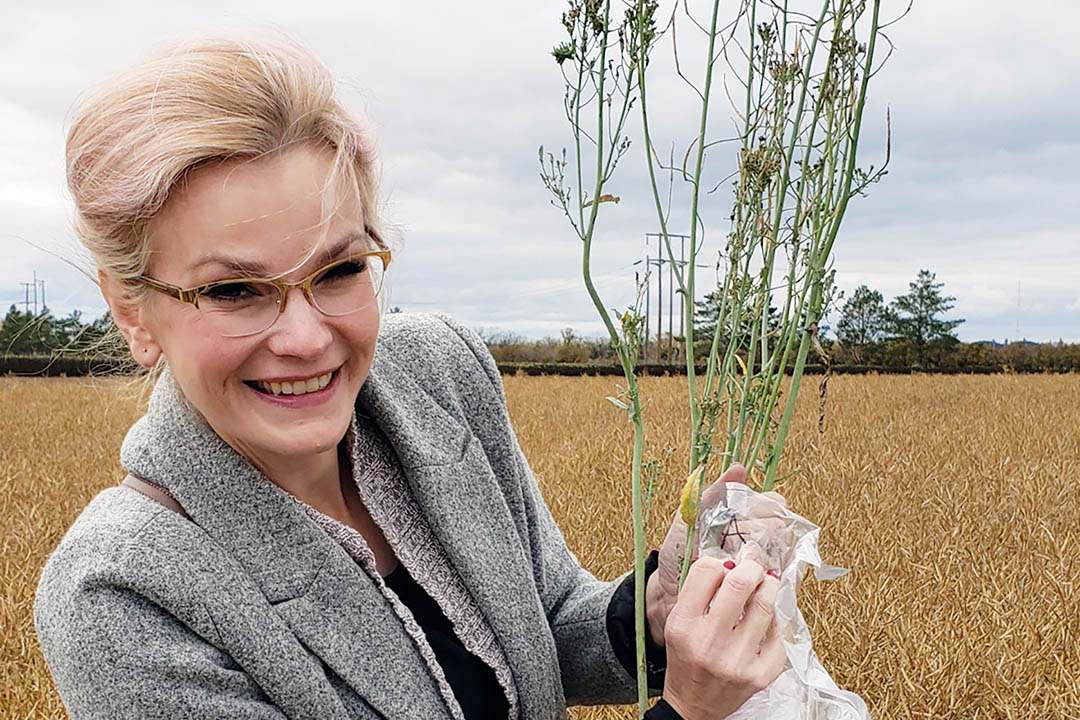
New USask disease detection tool may save millions for canola industry
The new testing can be done in the field in just one hour with accurate results.
By Federica GiannelliUniversity of Saskatchewan (USask) researchers have developed a new testing tool for faster, cheaper and easier detection of aster yellows, a leafhopper-borne disease that can devastate canola yields and farmers’ income.
“Our tool will help save precious time and resources for scientists, agronomists, and producers,” said USask biology PhD student Karolina Pusz-Bocheńska. “Farmers will be able to mitigate the potential damage to their crop yields. Our tool will help them understand whether they should spray pesticides right away to kill infected leafhopper insects.”
The canola season in Canada is short, and the disease spreads very fast, so understanding whether crops and insects are infected saves time and money. In 2012, the canola industry saw 80 per cent of fields infected and at least a $270-million loss.
The new testing can be done in the field in just one hour with accurate results. Regular lab tests can take from several days to two weeks, and are more expensive.
Aster yellows, caused by a bacteria-like organism, is carried by a variety of insects. It reaches Canada mainly through leafhoppers moving from the southern United States in the spring. When leafhoppers feed on infected crops they are unharmed, but they carry the organism in their bodies, ready to spread it to healthy plants, including vegetable crops such lettuce and carrots, when they feed again.
To detect whether leafhoppers are infected, the USask researchers extract and analyze DNA from the insects.
“It’s actually very simple. Farmers could even do the testing in the back of their trucks,” said Pusz-Bocheńska. “All you have to do is to crush a leafhopper on a special piece of paper and expose it to a certain temperature.”
After 20 minutes, the researchers use a fabric puncher on the crushed insect to obtain a sample that can then be analyzed with a LAMP assay—a DNA-amplifying method that also can be adapted to the field. The analysis accurately reveals whether the insect is positive for aster yellows. The test also can also indicate whether plant tissues are infected.
The USask research team’s results, published in Plant Health Progress, show that in the case of aster yellows, the LAMP assay technique more accurately detects the disease and is more sensitive than the usual gold standard test for DNA lab analysis.
“The development of this novel and more sensitive test was driven by one of our molecular scientists, Tim Dumonceaux, in response to our need to rapidly identify whether individual aster leafhoppers had aster yellows disease,” said Tyler Wist, Agriculture and Agri-Food Canada (AAFC) researcher and Pusz-Bocheńska’s co-supervisor along with USask biology professor Jack Gray.
“Now we can more accurately assess the risk of disease spread from those early arriving leafhoppers and warn the agricultural community if there is a risk.”
The novel testing technique could also be used for detecting a variety of insect-borne plant diseases, such as Dutch Elm Disease. Current testing for beetles carrying the disease can take weeks, so the research team is collaborating with the Saskatchewan government to calibrate their new test for detecting the disease.
“Our testing technique may also apply to human and animal health, such as for testing ticks for Lyme disease or mosquitos for Zika,” said Pusz-Bocheńska. “Now researchers at other universities are even trying to adapt a similar technique for rapid COVID-19 testing of human blood samples.”
The next step is to use the new technique to establish an aster yellows risk index for canola in the summer. While farmers cannot directly access the test yet, the research team is in touch with companies in Canada interested in licensing the technology and offering the test.
The novel testing is the result of a collaboration between AAFC scientists Wist, Tim Dumonceaux, and Chrystel Olivier and USask researchers, including former post-doctoral fellow Edel Pérez-López. The research is funded by AAFC.
Federica Giannelli is a CGPS-sponsored graduate student intern in the USask research profile and impact unit.
This article first ran as part of the 2020 Young Innovators series, an initiative of the USask Research Profile and Impact office in partnership with the Saskatoon StarPhoenix.
- 30 -
Article re-posted on .
View original article.

